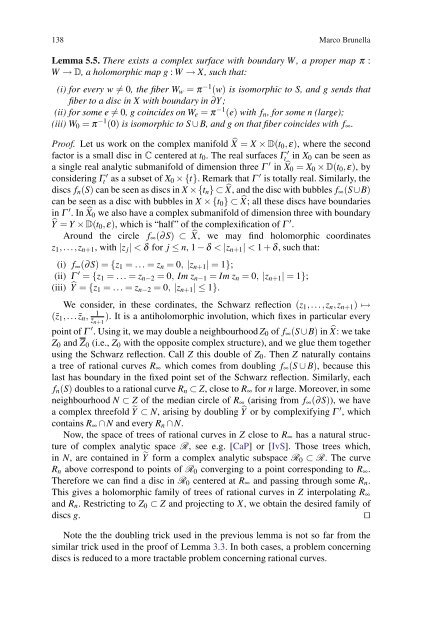Discrete Holomorphic Local Dynamical Systems
Discrete Holomorphic Local Dynamical Systems
Discrete Holomorphic Local Dynamical Systems
Create successful ePaper yourself
Turn your PDF publications into a flip-book with our unique Google optimized e-Paper software.
138 Marco Brunella<br />
Lemma 5.5. There exists a complex surface with boundary W , a proper map π :<br />
W → D, a holomorphic map g : W → X, such that:<br />
(i) for every w �= 0, the fiber Ww = π −1 (w) is isomorphic to S, and g sends that<br />
fiber to a disc in X with boundary in ∂Y;<br />
(ii) for some e �= 0, g coincides on We = π −1 (e) with fn,forsomen(large);<br />
(iii) W0 = π −1 (0) is isomorphic to S ∪ B, and g on that fiber coincides with f∞.<br />
Proof. Let us work on the complex manifold �X = X × D(t0,ε), where the second<br />
factor is a small disc in C centered at t0. The real surfaces Γ ′<br />
t in X0 can be seen as<br />
a single real analytic submanifold of dimension three Γ ′ in �X0 = X0 × D(t0,ε), by<br />
considering Γ ′<br />
t as a subset of X0 ×{t}. Remark that Γ ′ is totally real. Similarly, the<br />
discs fn(S) can be seen as discs in X ×{tn}⊂�X, and the disc with bubbles f∞(S∪B)<br />
can be seen as a disc with bubbles in X ×{t0}⊂ �X; all these discs have boundaries<br />
in Γ ′ .In�X0 we also have a complex submanifold of dimension three with boundary<br />
�Y = Y × D(t0,ε), which is “half” of the complexification of Γ ′ .<br />
Around the circle f∞(∂S) ⊂ �X, we may find holomorphic coordinates<br />
z1,...,zn+1, with |z j| < δ for j ≤ n,1− δ < |zn+1| < 1 + δ, such that:<br />
(i) f∞(∂S)={z1 = ...= zn = 0, |zn+1| = 1};<br />
(ii) Γ ′ = {z1 = ...= zn−2 = 0, Im zn−1 = Im zn = 0, |zn+1| = 1};<br />
(iii) �Y = {z1 = ...= zn−2 = 0, |zn+1|≤1}.<br />
We consider, in these cordinates, the Schwarz reflection (z1,...,zn,zn+1) ↦→<br />
1 (¯z1,...¯zn, ). It is a antiholomorphic involution, which fixes in particular every<br />
¯zn+1<br />
point of Γ ′ . Using it, we may double a neighbourhood Z0 of f∞(S ∪B) in �X:wetake<br />
Z0 and Z0 (i.e., Z0 with the opposite complex structure), and we glue them together<br />
using the Schwarz reflection. Call Z this double of Z0. ThenZnaturally contains<br />
a tree of rational curves R∞ which comes from doubling f∞(S ∪ B), because this<br />
last has boundary in the fixed point set of the Schwarz reflection. Similarly, each<br />
fn(S) doubles to a rational curve Rn ⊂ Z, close to R∞ for n large. Moreover, in some<br />
neighbourhood N ⊂ Z of the median circle of R∞ (arising from f∞(∂S)), we have<br />
a complex threefold �Y ⊂ N, arising by doubling �Y or by complexifying Γ ′ ,which<br />
contains R∞ ∩ N and every Rn ∩ N.<br />
Now, the space of trees of rational curves in Z close to R∞ has a natural structure<br />
of complex analytic space R, see e.g. [CaP] or[IvS]. Those trees which,<br />
in N, are contained in �Y form a complex analytic subspace R0 ⊂ R. Thecurve<br />
Rn above correspond to points of R0 converging to a point corresponding to R∞.<br />
Therefore we can find a disc in R0 centered at R∞ and passing through some Rn.<br />
This gives a holomorphic family of trees of rational curves in Z interpolating R∞<br />
and Rn. Restricting to Z0 ⊂ Z and projecting to X, we obtain the desired family of<br />
discs g. ⊓⊔<br />
Note the the doubling trick used in the previous lemma is not so far from the<br />
similar trick used in the proof of Lemma 3.3. In both cases, a problem concerning<br />
discs is reduced to a more tractable problem concerning rational curves.



